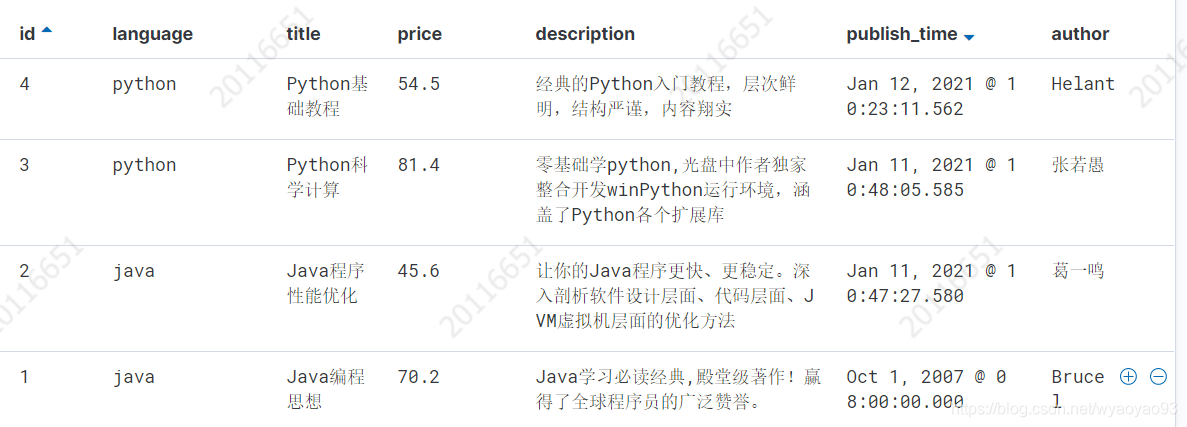21 Rest高级客户端实践(七):一个小案例
本文共 9418 字,大约阅读时间需要 31 分钟。
文章目录
1 准备
- 之前的索引
PUT books{ "settings": { "number_of_shards": 3, "number_of_replicas": 1 }, "mappings": { "properties": { "id":{ "type": "long" }, "title":{ "type": "text", "analyzer": "ik_max_word" }, "language":{ "type": "keyword" }, "author":{ "type": "keyword" }, "price":{ "type": "double" }, "publish_time":{ "type": "date", "format": "yyyy-MM-dd" }, "description":{ "type": "text", "analyzer": "ik_max_word" } } } } -
数据如下

-
构造这么一个查询,这里就不关心结果了,主要是如何使用java API构造这个一个请求
GET books/_search{ "query": { "bool": { "filter": [ { "term": { "author": "张若愚" } } ], "must": [ { "fuzzy": { "title": "python" } } ], "must_not": [ { "prefix": { "language": { "value": "j" } } } ], "should": [ { "range": { "price": { "gte": 0, "lte": 100 } } } ] } }, "highlight": { "fields": { "title": { } } }, "_source": { "excludes": ["id","publish_time"] }, "suggest": { "my_suggest": { "text": "python", "term": { "field": "description" } } }, "sort": [ { "price": { "order": "desc" } } ]} - 上面请求的结果
{ "took" : 5, "timed_out" : false, "_shards" : { "total" : 3, "successful" : 3, "skipped" : 0, "failed" : 0 }, "hits" : { "total" : { "value" : 1, "relation" : "eq" }, "max_score" : null, "hits" : [ { "_index" : "books", "_type" : "_doc", "_id" : "3", "_score" : null, "_source" : { "author" : "张若愚", "price" : 81.4, "description" : "零基础学python,光盘中作者独家整合开发winPython运行环境,涵盖了Python各个扩展库", "language" : "python", "title" : "Python科学计算" }, "highlight" : { "title" : [ "Python科学计算" ] }, "sort" : [ 81.4 ] } ] }, "suggest" : { "my_suggest" : [ { "text" : "python", "offset" : 0, "length" : 6, "options" : [ ] } ] }} 2 编码
package study.wyy.esclient.high;import com.fasterxml.jackson.databind.ObjectMapper;import org.apache.http.HttpHost;import org.elasticsearch.client.RestClient;import org.elasticsearch.client.RestHighLevelClient;/** * @author wyaoyao * @description * @date 2021/1/8 15:30 */public abstract class BaseTest { public static RestHighLevelClient client; public static ObjectMapper objectMapper; static { client = new RestHighLevelClient( RestClient.builder(new HttpHost("localhost", 9200, "http")) ); objectMapper = new ObjectMapper(); }} package study.wyy.esclient.high.search;import com.fasterxml.jackson.databind.ObjectMapper;import lombok.extern.slf4j.Slf4j;import org.elasticsearch.action.search.SearchRequest;import org.elasticsearch.action.search.SearchResponse;import org.elasticsearch.client.RequestOptions;import org.elasticsearch.common.unit.TimeValue;import org.elasticsearch.index.query.BoolQueryBuilder;import org.elasticsearch.index.query.QueryBuilder;import org.elasticsearch.index.query.QueryBuilders;import org.elasticsearch.search.builder.SearchSourceBuilder;import org.elasticsearch.search.fetch.subphase.highlight.HighlightBuilder;import org.elasticsearch.search.sort.FieldSortBuilder;import org.elasticsearch.search.sort.SortBuilder;import org.elasticsearch.search.sort.SortOrder;import org.elasticsearch.search.suggest.SuggestBuilder;import org.elasticsearch.search.suggest.SuggestBuilders;import org.elasticsearch.search.suggest.term.TermSuggestionBuilder;import org.junit.Test;import study.wyy.esclient.high.BaseTest;import java.io.IOException;/** * @author wyaoyao * @description * @date 2021/1/13 14:17 */@Slf4jpublic class SearchTest extends BaseTest { @Test public void test() throws IOException { // 1 构建SearchRequest SearchRequest request = buildSearchRequest(); // 2 执行请求 SearchResponse response = client.search(request, RequestOptions.DEFAULT); log.info(new ObjectMapper().writer().writeValueAsString(response)); } private SearchRequest buildSearchRequest() { SearchRequest request = new SearchRequest(); // 设置要搜索的索引 request.indices("books"); // 添加搜索条件,大多数搜索参数都是通过SearchSourceBuilder构建 // 构建SearchSourceBuilder SearchSourceBuilder searchSourceBuilder = new SearchSourceBuilder(); // 设置一些基本参数,超时时间,分页信息(from size)等 searchSourceBuilder.timeout(TimeValue.timeValueSeconds(10)); searchSourceBuilder.from(0); searchSourceBuilder.size(10); // 构建查询参数 QueryBuilder queryBuilder = buildQueryParam(); searchSourceBuilder.query(queryBuilder); // 设置高亮 HighlightBuilder highlightBuilder = new HighlightBuilder(); // title字段高亮 HighlightBuilder.Field title = new HighlightBuilder.Field("title"); highlightBuilder.field(title); searchSourceBuilder.highlighter(highlightBuilder); // 设置Suggest SuggestBuilder suggestBuilder = new SuggestBuilder(); TermSuggestionBuilder text = SuggestBuilders.termSuggestion("description").text("python"); suggestBuilder.addSuggestion("my_suggest",text); searchSourceBuilder.suggest(suggestBuilder); // source过滤 String[] excludes = { "id","publish_time"}; searchSourceBuilder.fetchSource(null,excludes); // 排序 FieldSortBuilder sortBuilder = new FieldSortBuilder("price").order(SortOrder.DESC); searchSourceBuilder.sort(sortBuilder); // 最后不要忘记将searchSourceBuilder添加到SearchRequest request.source(searchSourceBuilder); return request; } private QueryBuilder buildQueryParam() { QueryBuilder boolQueryBuilder = QueryBuilders.boolQuery() // 过滤 .filter(QueryBuilders.termQuery("author", "张若愚")) // 模糊查询 .must(QueryBuilders.fuzzyQuery("title", "python")) // 前缀查询 .mustNot(QueryBuilders.prefixQuery("language", "j")) // 范围查询 .should(QueryBuilders.rangeQuery("price").gte(0).lte(100)); return boolQueryBuilder; }} 最后的输出
{ "internalResponse":{ "numReducePhases":1, "fragment":true }, "scrollId":null, "totalShards":3, "successfulShards":3, "skippedShards":0, "shardFailures":[ ], "clusters":{ "total":0, "successful":0, "skipped":0, "fragment":true }, "profileResults":{ }, "numReducePhases":1, "terminatedEarly":null, "aggregations":null, "timedOut":false, "took":{ "hours":0, "minutes":0, "seconds":0, "nanos":12000000, "millis":12, "stringRep":"12ms", "micros":12000, "minutesFrac":0.0002, "hoursFrac":0.0000033333333333333333, "days":0, "microsFrac":12000, "daysFrac":0.00000013888888888888888, "millisFrac":12, "secondsFrac":0.012 }, "suggest":{ "fragment":true }, "failedShards":0, "hits":{ "hits":[ { "score":"NaN", "id":"3", "type":"_doc", "nestedIdentity":null, "version":-1, "seqNo":-2, "primaryTerm":0, "highlightFields":{ "title":{ "name":"title", "fragments":[ { "fragment":true } ], "fragment":true } }, "sortValues":[ 81.4 ], "matchedQueries":[ ], "explanation":null, "shard":null, "index":"books", "clusterAlias":null, "sourceAsMap":{ "author":"张若愚", "price":81.4, "description":"零基础学python,光盘中作者独家整合开发winPython运行环境,涵盖了Python各个扩展库", "language":"python", "title":"Python科学计算" }, "innerHits":null, "fields":{ }, "sourceRef":{ "fragment":true }, "rawSortValues":[ ], "sourceAsString":"{"author":"张若愚","price":81.4,"description":"零基础学python,光盘中作者独家整合开发winPython运行环境,涵盖了Python各个扩展库","language":"python","title":"Python科学计算"}", "fragment":false } ], "totalHits":{ "value":1, "relation":"EQUAL_TO" }, "maxScore":"NaN", "sortFields":null, "collapseField":null, "collapseValues":null, "fragment":true }, "fragment":false} 转载地址:http://yirv.baihongyu.com/
你可能感兴趣的文章
NIFI从MySql中增量同步数据_通过Mysql的binlog功能_实时同步mysql数据_配置binlog_使用处理器抓取binlog数据_实际操作01---大数据之Nifi工作笔记0040
查看>>
NIFI从MySql中增量同步数据_通过Mysql的binlog功能_实时同步mysql数据_配置数据路由_实现数据插入数据到目标数据库_实际操作03---大数据之Nifi工作笔记0042
查看>>
NIFI从MySql中离线读取数据再导入到MySql中_03_来吧用NIFI实现_数据分页获取功能---大数据之Nifi工作笔记0038
查看>>
NIFI从MySql中离线读取数据再导入到MySql中_无分页功能_02_转换数据_分割数据_提取JSON数据_替换拼接SQL_添加分页---大数据之Nifi工作笔记0037
查看>>
NIFI从PostGresql中离线读取数据再导入到MySql中_带有数据分页获取功能_不带分页不能用_NIFI资料太少了---大数据之Nifi工作笔记0039
查看>>
nifi使用过程-常见问题-以及入门总结---大数据之Nifi工作笔记0012
查看>>
NIFI分页获取Mysql数据_导入到Hbase中_并可通过phoenix客户端查询_含金量很高的一篇_搞了好久_实际操作05---大数据之Nifi工作笔记0045
查看>>
NIFI同步MySql数据_到SqlServer_错误_驱动程序无法通过使用安全套接字层(SSL)加密与SQL Server_Navicat连接SqlServer---大数据之Nifi工作笔记0047
查看>>
Nifi同步过程中报错create_time字段找不到_实际目标表和源表中没有这个字段---大数据之Nifi工作笔记0066
查看>>
NIFI大数据进阶_FlowFile拓扑_对FlowFile内容和属性的修改删除添加_介绍和描述_以及实际操作---大数据之Nifi工作笔记0023
查看>>
NIFI大数据进阶_Json内容转换为Hive支持的文本格式_操作方法说明_01_EvaluteJsonPath处理器---大数据之Nifi工作笔记0031
查看>>
NIFI大数据进阶_Kafka使用相关说明_实际操作Kafka生产者---大数据之Nifi工作笔记0036
查看>>
NIFI大数据进阶_NIFI的模板和组的使用-介绍和实际操作_创建组_嵌套组_模板创建下载_导入---大数据之Nifi工作笔记0022
查看>>
NIFI大数据进阶_NIFI监控的强大功能介绍_处理器面板_进程组面板_summary监控_data_provenance事件源---大数据之Nifi工作笔记0025
查看>>
NIFI大数据进阶_NIFI集群知识点_认识NIFI集群以及集群的组成部分---大数据之Nifi工作笔记0014
查看>>
NIFI大数据进阶_NIFI集群知识点_集群的断开_重连_退役_卸载_总结---大数据之Nifi工作笔记0018
查看>>
NIFI大数据进阶_内嵌ZK模式集群1_搭建过程说明---大数据之Nifi工作笔记0015
查看>>
NIFI大数据进阶_外部ZK模式集群1_实际操作搭建NIFI外部ZK模式集群---大数据之Nifi工作笔记0017
查看>>
NIFI大数据进阶_实时同步MySql的数据到Hive中去_可增量同步_实时监控MySql数据库变化_操作方法说明_01---大数据之Nifi工作笔记0033
查看>>
NIFI大数据进阶_离线同步MySql数据到HDFS_01_实际操作---大数据之Nifi工作笔记0029
查看>>